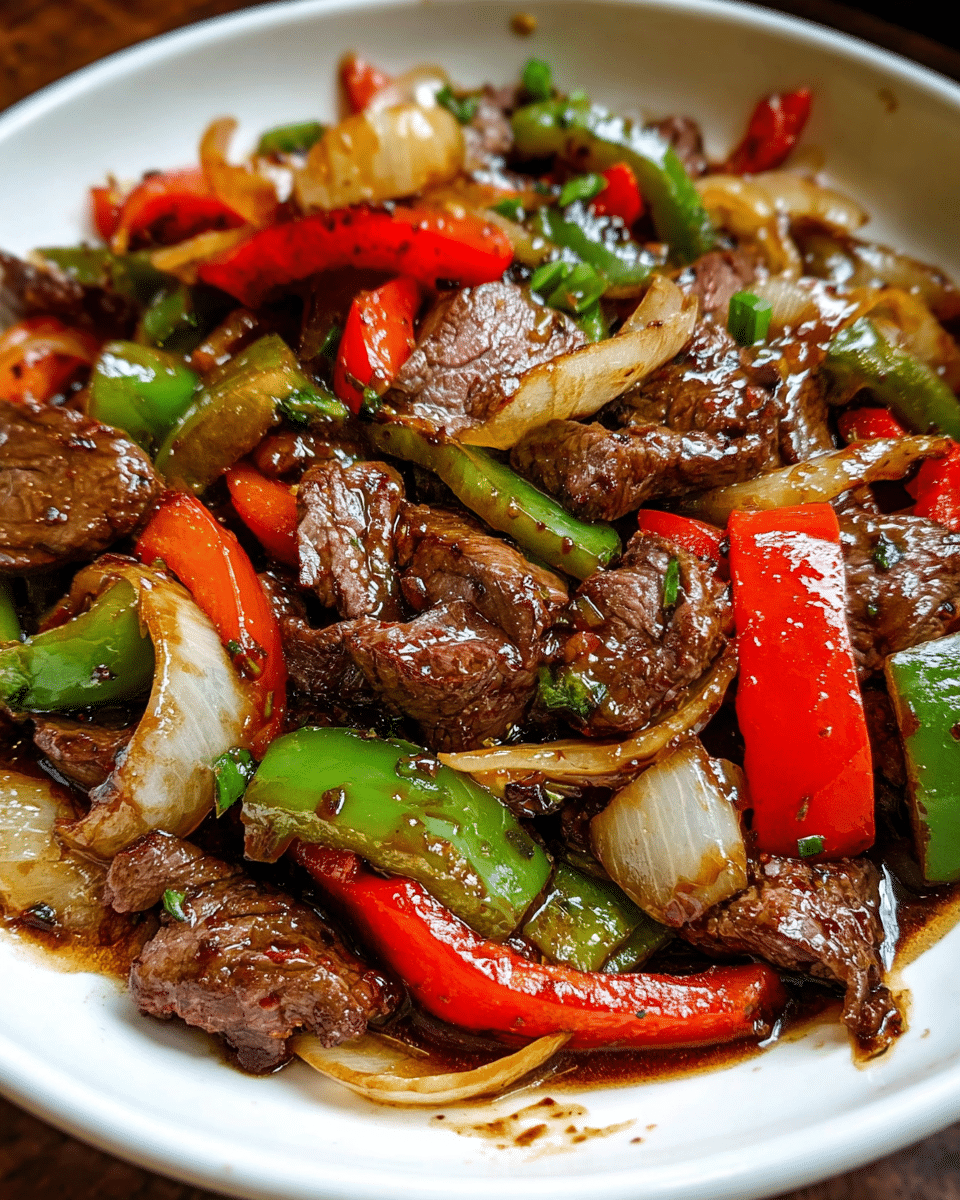The harmony of tender beef slices, vibrant bell peppers, and caramelized onions makes this Pepper Steak recipe a visual and flavorful delight. Seared to perfection and tossed in a rich, umami-forward sauce, it’s a dish that delivers both comfort and excitement in every bite.
Inspired by Chinese American stir fry traditions, this recipe balances texture and flavor beautifully. It’s fast, flexible, and fit for any night of the week equally perfect served with fluffy rice or slurpy noodles. Whether you’re a home chef or just hungry, this colorful skillet masterpiece belongs on your table.
Full Recipe:
Ingredients:
-
1 lb beef steak (sirloin, flank, or ribeye), thinly sliced against the grain
-
2 tablespoons soy sauce
-
1 tablespoon oyster sauce
-
1 teaspoon cornstarch
-
2 tablespoons vegetable oil
-
1 red bell pepper, sliced
-
1 green bell pepper, sliced
-
1 onion, sliced
-
2 cloves garlic, minced
-
1 teaspoon ginger, grated
-
1/4 cup beef broth or water
-
Salt and pepper to taste
Directions:
-
In a bowl, mix soy sauce, oyster sauce, and cornstarch. Add sliced beef and coat evenly. Marinate for at least 15 minutes.
-
Heat 1 tablespoon oil in a skillet or wok over high heat. Sear beef slices in a single layer for 1-2 minutes per side. Remove and set aside.
-
Add remaining tablespoon of oil to the skillet. Add sliced bell peppers and onion. Sauté for 3-4 minutes until crisp-tender.
-
Add garlic and ginger, sauté for 1 minute until aromatic.
-
Return seared beef to the skillet. Add beef broth or water and stir to combine. Let simmer for 2-3 minutes until the sauce slightly thickens.
-
Season with salt and pepper to taste. Serve hot with rice or noodles.
Prep Time: 15 minutes | Cooking Time: 15 minutes | Total Time: 30 minutes
Kcal: 310 kcal | Servings: 4 servings
Pepper Steak with Bell Peppers and Onion: A Flavorful Fusion of Culture, Nutrition, and Culinary Craft
There are certain dishes that manage to bring together the essence of comfort, speed, and flavor pepper steak with bell peppers and onion is one such culinary gem. This popular stir-fry style dish combines the juicy tenderness of seared beef with the crisp sweetness of bell peppers and the aromatic pull of onions and garlic, all bathed in a savory sauce that’s as rich in tradition as it is in umami depth.
At first glance, pepper steak may seem like just another stir-fry, but a closer look reveals a culturally layered, nutritionally balanced, and highly customizable meal that’s as suitable for weeknight dinners as it is for entertaining. Whether you’re an experienced home chef or someone just learning your way around a skillet, pepper steak holds the promise of a rewarding meal with minimal fuss.
A Dish Rooted in Global Influence
Though often associated with Chinese-American cuisine, the origins of pepper steak span multiple cultures and continents. The dish is essentially a fusion of stir-fry methods and Western-style meat-and-vegetable combinations, rooted in the Chinese tradition of using quick, high-heat cooking to bring out the best in simple ingredients.
The Chinese version typically using soy sauce, oyster sauce, and a touch of cornstarch has been adapted across the globe, especially in American kitchens where it became a takeout staple in the mid-20th century. Meanwhile, Western adaptations might involve grilling or searing beef before adding sautéed peppers and onions, often leaning into steakhouse style seasoning profiles.
What makes pepper steak special is this cross-cultural versatility: it is as much at home on a rice bowl as it is beside mashed potatoes, and its sauce can shift from gingery and garlicky to spicy or even sweet depending on the preferences of the cook.
The Flavor Profile: A Symphony of Umami and Freshness
One of the reasons pepper steak continues to win hearts and bellies is its dynamic flavor profile. The beef typically flank, sirloin, or ribeye brings richness and umami to the dish, especially when seared to develop a caramelized crust. Marinating the meat helps to lock in moisture and infuse flavor throughout each tender slice.
The bell peppers add a juicy crispness and subtle sweetness, especially when you mix red, yellow, and green varieties. This not only enhances flavor but also makes the dish visually vibrant. Onions, meanwhile, bridge the gap between savory and sweet they become soft and slightly caramelized during the sautéing process, adding depth without overpowering the palate.
The sauce often a blend of soy sauce, oyster sauce, garlic, ginger, and beef broth is what ties the entire dish together. It coats every bite without being too heavy, offering a luscious umami forward glaze that clings beautifully to both meat and vegetables.
Nutritional Balance on Your Plate
Despite its indulgent taste, pepper steak can be quite a healthy meal, especially when made at home with high-quality ingredients. It offers an excellent balance of macronutrients: protein from the beef, fiber and vitamins from the vegetables, and healthy fats from the oil used in cooking.
Beef is a rich source of iron, zinc, and B-vitamins, all essential for energy production and immune health. Choosing lean cuts helps reduce saturated fat without compromising flavor. Meanwhile, bell peppers are packed with antioxidants particularly vitamin C which supports skin health and immune function. Onions and garlic add anti-inflammatory properties and trace minerals to the mix.
For those following specific diets, the recipe can be modified easily. You can reduce sodium by using low sodium soy sauce or swap beef for plant based proteins or chicken. Serve it over brown rice or quinoa for added fiber, or enjoy it with steamed vegetables for a low-carb option.
Cooking Techniques That Make the Dish Shine
While pepper steak might sound like a quick skillet meal and it can be technique matters greatly. Thinly slicing the beef against the grain is key for tenderness. Marinating the meat, even briefly, improves its texture and amplifies the savory base.
Searing the beef in a very hot pan allows for a proper Maillard reaction, developing a flavorful crust without overcooking the interior. Overcrowding the pan is a common mistake doing the beef in batches keeps it from steaming instead of searing.
The vegetables should be cooked just long enough to soften slightly but still retain their bite and color. Adding aromatics like garlic and ginger at the right time after the vegetables have softened ensures their flavors are pronounced and not burnt.
The final stage combining everything with the sauce is what makes or breaks the dish. Simmering briefly allows the sauce to thicken and coat the ingredients without turning the peppers mushy or drying out the beef.
How to Customize It to Your Taste
One of the joys of pepper steak is its adaptability. Like a culinary canvas, it can be tailored to personal tastes or dietary needs:
-
Spicy kick: Add crushed red pepper flakes, fresh chili, or a spoonful of chili garlic sauce.
-
Sweeter glaze: Add a dash of hoisin sauce or honey to the sauce for a sweet-savory contrast.
-
Low-carb option: Serve the dish over cauliflower rice or lettuce cups.
-
Vegan version: Replace the beef with seared tofu or seitan, and use mushroom broth in place of beef broth.
-
Extra vegetables: Add snap peas, mushrooms, zucchini, or even baby corn to stretch the dish further.
These tweaks make it easy to keep the core idea of pepper steak while turning it into something new every time you make it.
Perfect Pairings and Serving Suggestions
Pepper steak is often served with steamed white rice, which soaks up the sauce perfectly. But it also pairs wonderfully with:
-
Jasmine or basmati rice: For extra aroma and lightness.
-
Noodles: Udon or rice noodles add texture and make it feel like a full noodle bowl.
-
Fried rice: For a more indulgent take, pair with homemade vegetable fried rice.
-
Grilled vegetables or salad: To lighten the meal and add crunch.
-
Mashed potatoes or crusty bread: Western twists that work surprisingly well.
To elevate presentation, sprinkle chopped scallions or sesame seeds on top. A side of pickled vegetables or cucumber salad can also balance the dish’s richness with brightness and crunch.
Common Mistakes to Avoid
Even a simple stir-fry can go wrong if a few key points are missed. Here are some common pitfalls to avoid:
-
Overcrowding the pan: This causes steaming instead of searing.
-
Skipping the marinade: The beef will lack flavor and tenderness.
-
Overcooking the vegetables: Bell peppers should still have a bit of bite.
-
Under-seasoning: Taste as you go and adjust the sauce as needed.
-
Using low heat: The beef and vegetables won’t caramelize properly.
Mastering these elements ensures your pepper steak delivers the wow factor every time.
Conclusion:
Pepper steak with bell peppers and onion is more than just a recipe it’s a celebration of balance, flavor, and cultural fusion. From the quick searing of beef to the colorful medley of vegetables, every element plays a role in delivering satisfaction in both taste and nourishment. Its simplicity hides the complexity of flavors it brings to the table, and its adaptability makes it a reliable go to meal for busy weeknights or casual weekend feasts.
Whether you’re cooking for your family, meal prepping for the week, or looking to impress dinner guests without a complicated menu, pepper steak stands as a dependable and delicious option. With just a little attention to detail and a few pantry staples, you can transform ordinary ingredients into an extraordinary dish that hits all the right notes.
So next time you’re wondering what to make for dinner, let this timeless stir-fry dish be your answer bold, satisfying, and endlessly customizable.






